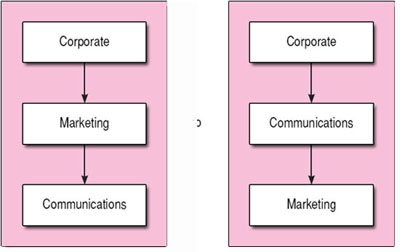2 The changing role of communications
Butterfield (1997) argues that the hierarchical model of planning which has traditionally placed communications alongside the other variables of the marketing mix is due for a rethink. This model starts with corporate strategy, which translates into a number of functional strategies (including marketing). It sees marketing communications as a subset of marketing strategy. Butterfield suggests that, because of the increased importance of company-wide brand values in providing competitive advantage, marketing is becoming a way of delivering a communications strategy, rather than the other way round. He points to firms such as Virgin or BMW where the company brand subsumes separate offerings, or to firms like the Body Shop where company values provide competitive differentiation. As in Figure 1, ‘in this ‘new’ model, communications starts with the company, and marketing becomes part of the ‘delivery mechanism’ for the communications strategy.’ (Butterfield, 1997, p. 87).

This does not mean that all marketing communication is automatically elevated to a strategic role. There is still a distinction to be made between tactical communications in support of specific marketing initiatives and strategic communications which emanate from the highest levels of the corporation to inform all its activities. However, it does support the view that communication is qualitatively different from the other elements of the marketing mix, or, as Butterfield puts it: ‘perhaps the classic marketing functions of product, price and distribution are today increasingly ‘hygiene factors’ whereas communications is a higher order tool’. Hygiene factors, according to Herzberg's classic theory of motivation, are what we take for granted in a situation. Their presence satisfies our basic needs, and we would notice their lack, but they do not have the power to motivate. As customers have become more sophisticated the competitive focus in marketing has moved upwards to benefits like image, self-expression and the assurance of quality. While the rest of the marketing mix needs to be securely in place to deliver these, effective communication of such benefits is becoming the key differentiator. This is particularly the case in companies with pervasive brand values, but it may mean a change in how all marketing departments see themselves:
‘Communications will stand above other elements of the marketing mix in these companies because it will define what the company stands for (its vision) and it is tasked with expressing that on behalf of the corporation: whether that be directly to stakeholders (employees, stakeholders, et al.), via PR, or through advertising etc. to customers. By contrast, marketing in those companies will be charged with physically delivering the corporate vision, via its products, to the end user….
Marketing departments have got used to the idea of the tactical integration of communications messages across different media. Increasingly in the future they will have to embrace the idea of strategic vertical integration – speaking with one voice from the CEO's office right down to the supermarket shelf – even though such a realignment may eclipse their former pre-eminent role.’
(Butterfield, 1997, p. 88)
What are the implications of this vision of vertically-integrated marketing communications? An obvious one is the importance of integrating internal and external marketing communications. An organisation's employees are highly credible ambassadors to its external publics – both in what they say to their communities and the service they provide to their customers. Both word of mouth and performance can be enhanced to the benefit of the organisation by a sustained programme of internal marketing. A second implication of the strategic vertical integration envisaged by Butterfield is the importance of developing distribution channels as conduits of information as well as of goods and money. Marketing communications writers frequently differentiate between ‘push’ and ‘pull’ strategies. ‘Push’ strategies (trade promotion and personal selling) offer incentives to distribution intermediaries to stock and actively merchandise products, pushing them towards the end user. ‘Pull’ strategies, on the other hand, use consumer-directed techniques (e.g. advertising and sales promotion) to stimulate demand in order to pull the product, or service, through the channel. The ‘push’ metaphor rankles with the accepted marketing wisdom of finding a need and satisfying it, rather than trying to impose what you have on a reluctant customer. Sustainable relationships between marketers and distribution intermediaries need to be based on mutual advantage, not power imbalance. It is likely, therefore, that a more vertically-integrated approach to communications will involve a blurring of the lines of demarcation between marketer and intermediary. Electronic data interchange (EDI) and the use of intranets are symptoms of this development in practice, as traditional distribution intermediaries are complemented, and in some cases replaced, by a new breed of ‘infomediaries’ connecting marketers to customers.
Push and pull strategies are not mutually exclusive. For example, an advertising campaign directed solely at the end user will be seen by intermediaries, bolstering their confidence in stocking the brand concerned. Fill (2002, p. 295) adds a further generic strategy: ‘profile’, which focuses on corporate image and reputation, internally, externally, or both. Techniques here include public relations, sponsorship and advertising aimed at developing a corporate brand. Again, this is hardly likely to be a watertight strategy in terms of what is received by the customer or intermediary. Yet, as Fill points out, the people responsible for each type of strategy (even if all three exist simultaneously) are likely to work independently of one another in most organisations. This situation is perhaps the major barrier to effective vertical integration of the kind envisaged by Butterfield – just as the proper integration of external marketing communication across different media and techniques is threatened by the various interests and territories involved.
Schultz and Kitchen (2000) propose a number of useful concepts for analysing and developing effective marketing communications strategy within the complexity of the contemporary market environment. As we have already observed, while it is necessary to operationalise marketing communications strategy by combining a number of different disciplines and media, customers experience brands in their own terms. In order to communicate in a customer-centred way, organisations need to consider how their brand messages are received. Figure 2 suggests some of the ways in which customers establish a view of your brand:

The diagram selects eight sources of marketing communications, but clearly there are as many as customers have ways of hearing about, seeing, or experiencing your brand. Public relations, sponsorship, word of mouth, packaging, signage, different forms of media advertising and sales promotion activity, internet searches, text messages, even litter in the streets – the list is extensive, and only partially controllable. This uncertainty makes it all the more important to think through brand contact points thoroughly, in order to gauge their potential implications. Schultz and Kitchen maintain that an organisation can improve its management of this process by a careful consideration of the different ways in which customers come into contact with the brand – offering a standardised chart, the Brand Contact Audit, as a framework for action planning (Table 1).
| Brand contact audit | ||||||
|---|---|---|---|---|---|---|
| Target Segment: | ||||||
| Contact points | Expectation at each | Experience at each | Message sent | Positive or negative | Importance of contact | Target for improvement |
Each row of cells considers a particular contact point. Service marketers have learned to measure customer satisfaction by asking customers to rate their experiences relative to their expectations of different aspects of the service (Parasuraman, et al., 1985). The brand contact audit process adopts a similar approach, taking into account how the source of information in each case has performed against expectations. The resulting insights can lead to some surprises:
‘Often we have found that contacts assumed to be positive were not positive at all. Knowing the types of existing brand contacts will do much to assist the communication planner in developing effective programs, especially in foreign cultures.’
(Source: Schultz and Kitchen, 2000, p. 101.)
Activity 1
Using the following grid, list up to five ways in which you come into contact with a brand of which you are a regular customer. This may be in the context of your personal consumption, or your professional life as a customer.
| Brand contact audit | ||||||
|---|---|---|---|---|---|---|
| Contact points | Expectation at each | Experience at each | Message sent | Positive or negative | Importance of contact | Target for improvement |
Are there any areas where this audit reveals the brand in question could do better with its communications?
As a follow up to this exercise, interview one of your own customers about how they encounter your brand. You may find, like Schultz and Kitchen, that the exercise produces some surprises.
Answer
An exhaustive list of all the ways in which customers come into contact with brands is salutary in reminding us of the complex web of marketing communications, but is of limited usefulness if we cannot do anything with the information. This exercise is most useful when the contacts are prioritised not only by how important they are to the customer but also by how much scope they offer the organisation for action.
